
- What is dehumidification?
- How do dehumidifiers help with my allergies?
- What causes moisture in the air indoors?
- What is relative humidity?
- Where do I put a dehumidifier?
- What are “commercial” dehumidifiers?
- What about AHAM ratings and saturation?
- What do the terms “capacity,” “pints per day,” and “CFM” mean?
- How do I know what size is right for me?
- Square Footage? Cubic Footage? Which Do I Use?
- What is porting?
- Do I need a condensate pump?
- How long will my dehumidifier last?
- What do I do when my dehumidifier stops working?
- Should I keep my dehumidifier box?
- How do I maintain and clean my dehumidifier?
- Are dehumidifiers heavy?
- How loud is a dehumidifier?
- Can I safely recycle the water my dehumidifier produces?
- How will using a dehumidifier effect my power bill?
- What are other ways that I can reduce moisture in my home?
- How often do I run my dehumidifier?
- What’s the difference between the Danby 70 Pint Dehumidifiers?
Dehumidifier FAQs
Dehumidification is the process of removing excess moisture from the air in your home and is primarily accomplished through the use of a dehumidifier. But how do dehumidifiers work? Dehumidifiers work by combining threebasic principles: cooling the air, adsorption, and absorption. Most home dehumidifiers–like Danby, Stadler Form, Soleus, and Santa Fe–work on the first principle. By using coolant, home dehumidifiers cool the air below the dew point which causes the moisture in the air to condense. The water is captured in a drain bucket or pan. This same principle is also true for commercial/industrial dehumidifiers. Dri-Eaz and Ebac dehumidifiers come equipped with larger fan motors, drain buckets, or internal condensate pumps to condense, collect and drain water away.
Smaller dehumidifiers, such as our Eva-Dry Dehumidifiers, work through adsorption. Adsorption is the process whereby chemicals, particles, or whatever you are trying to remove adheres to the outer surface of an adsorbent, generally called desiccant. A porous, odorless, non-toxic and safe silica gel will adsorb water up to 40% of its own mass. An indicator lets you know when to dry these mini dehumidifiers. Via a small amount of electricity, heat reactivates the gel and returns its water adsorbing capability. The Ebac desiccant dehumidifier is a larger version of this principle. This model must be ducted to push the moisture collected by the desiccant out and away from the air you are drying. The last type of dehumidification is absorption. For home applications, this type of dehumidification is the least used. It involves an absorbent material such as calcium chloride which is hard to reactivate once it has absorbed moisture.
How will a dehumidifier help with my allergies?
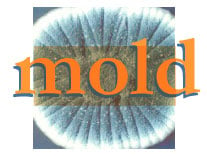 Some of the most common allergens are directly affected by humidity levels in your home. Mold and dust mites flourish in more humid environments. According to the EPA and other sources, mold generally thrives in relative humidity levels as low as 60-65%. Dust mites live and breed at levels over 50%. For these reasons, our best advice is to keep your household relative humidity under 50% whenever possible. Dehumidifiers are a crucial component in keeping relative humidity levels low. Most of the models we sell have a built in humidistat that gives a relative humidity reading, but for use throughout the home you can use an Acu-Rite Digital Humidity Gauge. Overall, maintaining a relative humidity of less than 50% will greatly reduce or eliminate dust mites, mold, mildew, insects and other allergens.
Some of the most common allergens are directly affected by humidity levels in your home. Mold and dust mites flourish in more humid environments. According to the EPA and other sources, mold generally thrives in relative humidity levels as low as 60-65%. Dust mites live and breed at levels over 50%. For these reasons, our best advice is to keep your household relative humidity under 50% whenever possible. Dehumidifiers are a crucial component in keeping relative humidity levels low. Most of the models we sell have a built in humidistat that gives a relative humidity reading, but for use throughout the home you can use an Acu-Rite Digital Humidity Gauge. Overall, maintaining a relative humidity of less than 50% will greatly reduce or eliminate dust mites, mold, mildew, insects and other allergens.
Where does indoor moisture in the air come from?
Most of our everyday activities contribute to increased humidity in the home. Showering can add a 1/2 pint of water into the air. Simply preparing meals adds approximately 5 pints of water to indoor air for a family of four over course of a day. Washing your laundry, mopping, using the dishwasher and even indoor plants contribute moisture to indoor air. Our most basic activity of breathing can add 1/2 a pint of moisture to the air over four hours. In a home of 1000 square feet with a constant temperature, four to six pints of water can increase relative humidity from 15% to as much as 60%. This doesn’t even include sources like leaking pipes and open or drafty windows. As you can see, the most basic activities have a growing impact on indoor humidity levels. In a relatively short period of time, elevated humidity levels create a suitable environment for mold and dust mites to flourish.
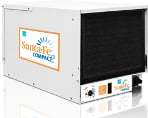 Relative humidity is a percentage showing how much water vapor is currently trapped in the air relative to the maximum amount of water vapor the air can hold at a given temperature. Imagine that you have a glass of water and begin to stir sugar into the water. When you get to point where you have put a full cup of sugar in the glass, you notice that the sugar no longer dissolves and that it begins accumulating at the bottom. At this point, the water is saturated with sugar and will hold no more. At the point where you have put only 1/2 a cup of sugar in the water, you are at 50% of the maximum the water can hold at the current temperature. Temperature can effect relative humidity. Take two glasses of the same size. Add ice to one then fill both to the same level with water. Now try the same technique as before, add sugar while stirring. The glass of ice water will stop dissolving sugar sooner than the other, and this is due to the lower temperature. Now, think of the air in your home as that glass of water and the moisture vapor in the air as the sugar. Your relative humidity level is the ratio of the current amount of water vapor in the air relative to the maximum amount of water vapor it will hold at a given temperature.
Relative humidity is a percentage showing how much water vapor is currently trapped in the air relative to the maximum amount of water vapor the air can hold at a given temperature. Imagine that you have a glass of water and begin to stir sugar into the water. When you get to point where you have put a full cup of sugar in the glass, you notice that the sugar no longer dissolves and that it begins accumulating at the bottom. At this point, the water is saturated with sugar and will hold no more. At the point where you have put only 1/2 a cup of sugar in the water, you are at 50% of the maximum the water can hold at the current temperature. Temperature can effect relative humidity. Take two glasses of the same size. Add ice to one then fill both to the same level with water. Now try the same technique as before, add sugar while stirring. The glass of ice water will stop dissolving sugar sooner than the other, and this is due to the lower temperature. Now, think of the air in your home as that glass of water and the moisture vapor in the air as the sugar. Your relative humidity level is the ratio of the current amount of water vapor in the air relative to the maximum amount of water vapor it will hold at a given temperature.
Where do I put a dehumidifier?
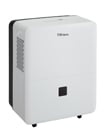 Most of our non-commercial dehumidifiers work best when placed in one room. There are several sizes available to fit any room in your house. Danby and Soleus dehumidifiers range in size, while the Stadler Form dehumidifier is limited to one size. All of these models will work well in your basement, laundry room, living room, or bedroom. By far, the most common area to place a unit is either the basement or laundry room because these rooms tend to be on the lower levels of the home and spaces where humidity can be the highest. These areas have constant contact with the moisture of the surrounding earth which makes them more susceptible to moisture problems. In reality, you can use a dehumidifier in any room where moisture and humidity levels lead to problems. Other residential humidifiers like Santa Fe and AprilAire are specifically built for use in your basement, crawlspace or to be tied directly into your HVAC system for whole home dehumidification.
Most of our non-commercial dehumidifiers work best when placed in one room. There are several sizes available to fit any room in your house. Danby and Soleus dehumidifiers range in size, while the Stadler Form dehumidifier is limited to one size. All of these models will work well in your basement, laundry room, living room, or bedroom. By far, the most common area to place a unit is either the basement or laundry room because these rooms tend to be on the lower levels of the home and spaces where humidity can be the highest. These areas have constant contact with the moisture of the surrounding earth which makes them more susceptible to moisture problems. In reality, you can use a dehumidifier in any room where moisture and humidity levels lead to problems. Other residential humidifiers like Santa Fe and AprilAire are specifically built for use in your basement, crawlspace or to be tied directly into your HVAC system for whole home dehumidification.
What are “commercial” dehumidifiers?
Our most popular commercial dehumidifiers are manufactured by Ebac and Dri-Eaz. These heavy duty units are constructed primarily of steel instead of the ABS plastic commonly found in typical home dehumidifiers. In the case of Dri-Eaz, they use a heavy-duty, rotomolded polyethylene that doesn’t crack, break or become brittle like traditional plastics. Many come with built in condensate pumps, operate in temperatures as low as 33° F, and offer higher water extraction rates than typical home dehumidifiers. These units are generally more expensive, shipped via truck freight (as opposed to parcel service), and built for the rigors of crawlspaces, restoration sites, construction sites, and industrial settings. These units are equipped to operate in settings where the moisture being extracted could be contaminated with harmful or noxious substances. To see a sample listing of the various uses of our commercial Ebac dehumidifiers, visit our A to Z Guide of Uses for Ebac Dehumidifiers.
Dri-Eaz are primarily used for restoration and water damage projects where maximum drying in a rugged or contaminated environment is a necessity. Most are stackable so that you can use more than one in any area while utilizing vertical space. Ideal for the cleanup of “gray water” Dri-Eaz has a dehumidifier for nearly any restoration or water damage project.
What do the terms “capacity,” “pints per day,” and “CFM” mean?
These are critical dehumidifier FAQs, as they are often the basis upon which most dehumidifiers are initially compared. These are three different terms commonly used when describing the extraction capabilities of a dehumidifier. “Capacity” is the amount of water the drain bucket will hold before having to be emptied. It can also be used to describe how much water, under specified conditions, a dehumidifier can extract from the air in a twenty-four hour period. This will vary based on several factors. In the first case, larger capacity dehumidifiers will hold more water and mean less frequent trips outdoors or to the drain to empty them, they also mean that the full bucket will be heavier. If you are porting your dehumidifier, the capacity is not nearly the concern that the pints per day is. For the second use of that term, this is a measure that you’ll want to pay attention to, particularly with regard to the severity of your moisture problem and the size of the space you are wanting to dry.
“Pints per day” (or PPD) refers to the maximum number of pints of water a particular dehumidifier will remove from the air during a 24 hour period. This is the measurement term that is most often associated with the second use of the term “capacity”. If you have a 70 pint dehumidifier that most often means that under AHAM rating conditions (60% Relative Humidity @ 80° F), this unit will remove up to 70 pints of water per day. That same unit can often remove MORE than the 70 pints per day rating if conditions are more severe, i.e. the temperature is higher than 80 or the relative humidity is higher than 60%, and for conditions below AHAM, performance will drop accordingly.
“CFM” or Cubic Feet per Minute is the same measurement used in many HEPA air purifiers. This number represents the volume of air the fan will move in any particular appliance. The greater the CFM, the more air that is cycled through a dehumidifier for moisture removal every minute. Commercial models built for more rugged applications typically have a higher CFM than home/room models. Many people also equate CFM with how powerful a dehumidifier or the blower/fan of a dehumidifier is.
What about AHAM ratings and saturation?
AHAM rates apply not only to air purifiers but also dehumidifiers. When it comes to dehumidifiers, AHAM certifies that the PPD that a manufacturer claims their product will remove is accurate. AHAM also certifies that power consumption for a given model is in line with manufacturer stated specifications. With PPD, AHAM will test a dehumidifier in a controlled environment that has a temperature of 80° F and relative humidity of 60%. Under these conditioners a dehumidifier is tested for 24 hours to determine whether or not the actual amount of moisture removed from the air is what the manufacturer claims.
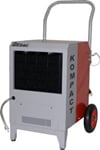 With our Ebac and Dri-Eaz dehumidifiers, you will find not only a PPD rating but also another number given for another set of conditions. “Saturation” is best described as an extreme condition where the amount of moisture in the air is so much that the dehumidifier will run constantly over a 24 hour period. Some examples are a flooded basement, clean up site after a natural disaster, or an industrial environment that continually saturates the air with moisture. Instead of the controlled environment of AHAM testing, the extraction rate provided at saturation or under extreme conditions will often far exceed typical dehumidifier results.
With our Ebac and Dri-Eaz dehumidifiers, you will find not only a PPD rating but also another number given for another set of conditions. “Saturation” is best described as an extreme condition where the amount of moisture in the air is so much that the dehumidifier will run constantly over a 24 hour period. Some examples are a flooded basement, clean up site after a natural disaster, or an industrial environment that continually saturates the air with moisture. Instead of the controlled environment of AHAM testing, the extraction rate provided at saturation or under extreme conditions will often far exceed typical dehumidifier results.
How do I know what size is right for me?
There really is no easy answer to this question, and deciding which model and size is right for you will depend on several factors.
You need to ask yourself several questions before purchasing.
- How severe is my moisture problem?
- How large is the room/location where the dehumidifier will be used?
- Under what conditions will my dehumidifier typically operate?
- Is energy consumption a primary concern?
- Will I port the unit or empty the drain bucket?
- How much do I want to spend?
With a mold or mildew smell and some dampness, a small to mid-size pint model would be a logical place to start. If your problem is more severe, with visible condensation on the floors and walls, you will need to opt for a larger room style dehumidifier, the Soleus 95 pint, or a more heavy duty model like a Dri-Eaz or Santa Fe dehumidifier. Power consumption is also no small matter. Annual costs can add up quickly if you are using a dehumidifier throughout the year. Whether or not there is a direct drain (porting) option or included condensate pump can also be very important for situations where the dehumidifier is likely to run often. Small to midsize units would be better suited in the upper floors of your home, while the larger units would be best suited for the lower levels. As a basic guide for home usage,
- Use a 30-45 pint model for small (8′ x 10′) to medium (15′ x 15′) rooms with moderate levels of humidity (45-55%)
- Use a 50 pint model for small to large (20′ x 20′) rooms with moderate to high humidity levels (55-65%)
- Use 65, 70, and larger pint models for large to extra large rooms (20′ x 30′) or rooms with high humidity (65% and above)
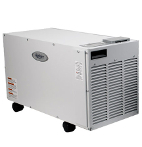 Remember, these are just basic guidelines that do not take into account other important factors. If you are placing the dehumidifier in a crawlspace or basement, you want to consider a Santa Fe or AprilAire dehumidifier. These are heavy duty and equipped to handle the rigors of the elements.
Remember, these are just basic guidelines that do not take into account other important factors. If you are placing the dehumidifier in a crawlspace or basement, you want to consider a Santa Fe or AprilAire dehumidifier. These are heavy duty and equipped to handle the rigors of the elements.
Dehumidifiers are not an end-all solution. If you have recurrent problems with moisture in your home, consider finding and remedying the source of the moisture. A leaking roof, a cracked foundation, older pipes, backed up drain lines, and inadequate ventilation are more severe problems that could be at the source of excess moisture in your home, and all are problems that no dehumidifier can truly fix.
Square Footage? Cubic Footage? Which Do I Use?
Another of the most common dehumidifier FAQs deals with coverage area. When comparing dehumidifiers, you might notice that some manufacturers will rate their products for a certain square footage while others will rate them for up to a specific cubic footage. So which do you use, and how can you make an apples to apples comparison? Quite simply, that’s tricky. Cubic footage is a much more accurate measurement since it gives you a volume of space, taking into account all dimensions of a room. The volume of air in a given space is determined by the Length, Width, and Height. Square footage is calculated by only two dimensions, Length and Width. This ignores ceiling height and the actual amount of air/space in a room. Using square footage will give you a rough estimate upon which to make your decision, but cubic footage will allow for a more precise guess as to which dehumidifier will work in your space.
If you are trying to compare two models that list their coverage differently, one thing you can do to help sort this out is to take measurements of the space where you plan to use the dehumidifier. Then multiply that out to get your cubic footage (L x W x H). You can then compare the CFM (Cubic Feet per Minute) to get a good idea of how quickly a dehumidifier could theoretically dry all the air in your space. For example, Dehumidifier A has as CFM of 300 and coverage listed as 3000 cu. ft. then in a tightly sealed space, the dehumidifier could cycle through all the air six times every hour. If Dehumidifier B is listed for 250 CFM, it would cycle the air through five times every hour in that same space. If both are 60 pint dehumidifiers under AHAM testing standards then your higher CFM model will likely extract more moisture in real world conditions. This isn’t to say CFM is the only metric to consider, but with all other things being equal (except one model rated in square footage and the other in cubic footage), it can help you make a better one to one comparison of models.
 Porting is the process of using an exterior drain line to continuously drain your dehumidifier. As mentioned above, most of the dehumidifiers we offer come with a port where a plastic or rubber hose can be attached to drain the water collected from the unit. A suitable type and length of hose can be purchased from your local hardware store. Porting is a fairly simple process that only works when gravity is on your side. The dehumidifier needs to be placed in a higher position than the receptacle where you want the water to drain into. If this is not possible due to a grade or a lack of a nearby drain, you can still port your dehumidifier, but you will require a condensate pump to push the water over a longer horizontal distance or even vertically.
Porting is the process of using an exterior drain line to continuously drain your dehumidifier. As mentioned above, most of the dehumidifiers we offer come with a port where a plastic or rubber hose can be attached to drain the water collected from the unit. A suitable type and length of hose can be purchased from your local hardware store. Porting is a fairly simple process that only works when gravity is on your side. The dehumidifier needs to be placed in a higher position than the receptacle where you want the water to drain into. If this is not possible due to a grade or a lack of a nearby drain, you can still port your dehumidifier, but you will require a condensate pump to push the water over a longer horizontal distance or even vertically.
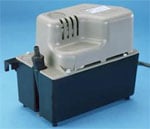 A dehumidifier condensate pump is a simple pump device that pushes fluids much in the same way a sump pump does. The only difference is a condensate pump is built mainly for the purpose of moving moisture removed by dehumidification. This small pump attaches to the dehumidifier the same as if you were simply porting it. You run a hose from the dehumidifier to the condensate pump and then a separate line runs from the pump to your drain. A condensate pump allows for continuous drainage of your dehumidifier and eliminates the hassle of emptying a heavy water bucket. This is a simple and inexpensive solution to use when there are no drain lines readily available for your dehumidifier, or when gravity is working against you. The condensate pump pictured is for use with home dehumidifiers and even HVAC systems, and can pump water both horizontally AND vertically. Some models in the Ebac, Dri-Eaz, and Santa Fe lines of dehumidifiers come with an integrated condensate pump, while for many others, it’s an optional feature or part of a package purchase.
A dehumidifier condensate pump is a simple pump device that pushes fluids much in the same way a sump pump does. The only difference is a condensate pump is built mainly for the purpose of moving moisture removed by dehumidification. This small pump attaches to the dehumidifier the same as if you were simply porting it. You run a hose from the dehumidifier to the condensate pump and then a separate line runs from the pump to your drain. A condensate pump allows for continuous drainage of your dehumidifier and eliminates the hassle of emptying a heavy water bucket. This is a simple and inexpensive solution to use when there are no drain lines readily available for your dehumidifier, or when gravity is working against you. The condensate pump pictured is for use with home dehumidifiers and even HVAC systems, and can pump water both horizontally AND vertically. Some models in the Ebac, Dri-Eaz, and Santa Fe lines of dehumidifiers come with an integrated condensate pump, while for many others, it’s an optional feature or part of a package purchase.
How long will my dehumidifier last?
If your unit does not run every day or 24 hours a day, it will inevitably last longer. Most of the units we carry are durable and typically last from 5 to 15 years though most have warranties that are shorter than that time frame. As long as your unit is not running constantly, the only thing that will shorten your dehumidifier’s lifespan is freezing temperatures. Some have features that will prevent the unit from running in low temperatures, and other dehumidifiers have de-icing/defrost capabilities to thaw frozen coils. In low temperatures, the coils will freeze, but some units will continue to run. You waste electricity as well as the wear and tear on the motor, while getting no dehumidification results. To protect the unit and prevent wasting energy, some units have automatic shutoff points at low temperatures. Durability is a factor, and generally, the most durable units will often feature heavier, steel construction and cost you more.
What do I do when my dehumidifier stops working?
Your first step would be to reference the user manual to check any simple troubleshooting measures. While a dehumidifier is a simple appliance, there are several things that could go wrong with it. From sensors, air filters and a humidistat to heating and cooling coils there are several aspects of a dehumidifier that could be malfunctioning. Some have filters that need to be changed, other times a certain feature has stopped working such, as a faulty humidistat causing the dehumidifier to run constantly. In most instances you will want to locate your closest servicing dealer. Contact the manufacturer and they can point you in the right direction. With an Ebac, Santa Fe and sometimes Dri-Eaz models you can often order replacement parts for a DIY repair. If the dehumidifier is under warranty the repairs likely will cost little if anything at all. Though, sometimes you may have to pay to ship it to a repair facility. If your unit is beyond its warranty, you may find it less expensive to purchase a new dehumidifier rather than repair your current one. If this is the case, contact the manufacturer or a local organization about recycling options. As with all of our products should you have a problem with a dehumidifier you purchased from us at AchooAllergy.com, contact customer service, toll-free, at 1-800-339-7123 for an exchange of a defective or malfunctioning dehumidifier.
 Should a dehumidifier you purchase from us encounter problems due to no fault of your own within 60 days of purchase, you can contact customer service to obtain a Return Authorization number and exchange the unit. For this reason, we recommend you keep the box your dehumidifier arrived in for at least 60 days. If you have the storage space you may want to keep the box for as long as the manufacturer’s warranty time period.
Should a dehumidifier you purchase from us encounter problems due to no fault of your own within 60 days of purchase, you can contact customer service to obtain a Return Authorization number and exchange the unit. For this reason, we recommend you keep the box your dehumidifier arrived in for at least 60 days. If you have the storage space you may want to keep the box for as long as the manufacturer’s warranty time period.
How do I maintain my dehumidifier?
There is very little regular maintenance required for dehumidifiers. For most models, including Danby, Soleus, and Stadler Form, you simply unpack them and plug them in. The primary maintenance with these units is disposing of the water collected in the drip/condensate tanks. Most come with convenient built in handles so after you slide the bucket out of the unit you can easily carry it outside or to your drain to dump. A more convenient option is to port your dehumidifier. Nearly all of these units come with a small port toward the bottom or on the back off the unit. From this port you run a small hose to an existing drain. Some people find it best to tie this drain line into your existing HVAC drain line (for moisture produced by your air conditioner) or possibly to a basement drain. From time to time you may want to check the tank and make sure it is clean and check the drain line (if ported) for blockage. If the unit has a removable cover you should check and clean the condensing coils annually. Air filters are often a coarse mesh that can simply be vacuumed or rinsed off. Air dry and reinstall them.
The larger the unit means the heavier it will be. Though medium to large home units weigh between 35 and 55 pounds most come equipped with casters, so on hard surfaces, moving them is not difficult. The smaller units (20 to 35 pounds), usually have hand holds built into the sides and some of these units have casters as well. For our commercial/industrial Ebac dehumidifiers the weight can range from 50 lbs. to as much as 353 lbs. AprilAire and Santa Fe models are also heavy crawlspace/basement dehumidifiers, but generally once in place, you do not move them. The all steel construction of most of these dehumidifiers lends itself not only to their heavy-duty, durable nature, but also to their increased weight. The weight for each dehumidifier we sell is listed in the specifications section on each product’s webpage.
As with any appliance that has a fan, the higher the fan setting the more noise these units will make. Honestly, for those who have owned older dehumidifiers, you likely will find that many of the home or room models we offer are much quieter than what you are used to. For those who have never owned a dehumidifier, the noise level may seem loud, particularly when close to the machine. To give you some comparison, the noise equivalent for most of these models is that of a basic air purifier. On higher settings the noise may keep you up at night if the unit is in your room, but on the lower settings, the noise is comparable to white noise which actually helps many people sleep. With the commercial models we offer, the noise can be greater, but these units are typically used outdoors, in industrial settings, and often locations where noise is not a primary concern. Crawlspace and basement dehumidifiers are often quiet enough that the only time you may hear them is if you are directly over them when the house is completely quiet. Other than this, the noise level blends into the everyday sounds found in a typical home. The quietest dehumidifier we offer is the Stadler Form Albert. On its highest setting it is quieter than comparable Danby, Soleus, or any other room dehumidifier on its LOWEST fan setting.
Can I safely recycle the water my dehumidifier produces?
 This is a “yes, but” answer. If you are not porting water away from your dehumidifier, there are many things you can do with the condensate that your dehumidifier produces. Keep in mind that the water produced by air conditioners and dehumidifiers is not meant for human consumption. While it will often initially be free of pathogens, it can stagnate quickly. If the tank is not kept clean, the water could become contaminated if fungi or other organisms begin to grow in your tank. What also makes it unfit for human consumption is that dehumidifier water often lacks the mineral and inorganic substances that make water potable. This also means you should not use the water to fill your pet’s water dish.
This is a “yes, but” answer. If you are not porting water away from your dehumidifier, there are many things you can do with the condensate that your dehumidifier produces. Keep in mind that the water produced by air conditioners and dehumidifiers is not meant for human consumption. While it will often initially be free of pathogens, it can stagnate quickly. If the tank is not kept clean, the water could become contaminated if fungi or other organisms begin to grow in your tank. What also makes it unfit for human consumption is that dehumidifier water often lacks the mineral and inorganic substances that make water potable. This also means you should not use the water to fill your pet’s water dish.
The best use is for watering your plants or gardens. Here in Georgia, where water seems to be at a premium due to a prolonged drought, you can use your dehumidifier water to water your indoor plants or use it outside for a vegetable garden, flowers, or other landscaping you may have. While you cannot drink the water, it still can be put to good use.
Depending on the environment, this same advice will hold true for our commercial/industrial dehumidifiers. The exception would be while using a dehumidifier in an environment where there is toxic and harmful chemicals in the air. In these instances the condensate produced may contain these substances and should be handled accordingly.
How will using a dehumidifier impact my power bill?
The majority of the home/room dehumidifiers we offer are Energy Star compliant. Looking for dehumidifiers with the Energy Star logo will help to ensure that your purchase is not wasting electricity. Differences in your power bill will vary according to size and how often the unit runs during an average month, but you can probably expect that with daily usage your cost of operation to range from $5 to an additional $10-$15 per month. Again, this will vary depending on the model you choose and how often it is used. For basements and crawlspaces, the most energy efficient model available today is the Santa Fe Impact XT dehumidifier. It exceeds Energy Star minimum requirements by 50% and removes more water per kilowatt of power than any other model available. As a final note, you will find that often the larger dehumidifiers are Energy Star compliant while many smaller ones will lack this designation.
With our commercial dehumidifiers power consumption will vary greatly with use. Some are built for extremely large or damp environments and actually run on 220V instead of the 110V found in most home receptacles. The larger motors and fans found in these units also lend themselves to greater power consumption.
What are other ways I can reduce moisture in my home?
This is one of the dehumidifier FAQs that shouldn’t be overlooked as reducing moisture at the source can help to reduce the problem before it starts. There are several other things you can do, in conjunction with the use of a dehumidifier, to help reduce the level of humidity in your home. First, make sure there are no leaks or seepage in and around your home. Improper landscaping, leaking pipes, faulty gutters and clogged drains can all increase the amount of water and moisture in and around your home. Next, use your dryer. Some of us like to allow certain articles of clothing to air dry for fear of shrinkage in the dryer. By allowing laundry to air dry in your home, you are increasing the overall humidity levels. Always remember to use exhaust fans whenever possible. While using the dryer helps, inspect the vent to make sure it is actually vented to the exterior of your home and inspect the hose for cracks or leaks. In the bathroom and kitchen exhaust fans can quickly remove excess moisture out of your home. By keeping doors open in your home you can allow air to circulate from room to room. By allowing heat to circulate, you can bring warm air to colder places where moisture is likely to condense. Lastly, it always helps to air out your home from time to time.
How often do I run my dehumidifier?
How often you run a dehumidifier depends on several factors, mainly – How humid is the space and what type of space is it? For living spaces, you may not want to run the dehumidifier as often since a common byproduct is heat. For instance, if the house is empty during the day while you are at work, it would be prudent to run the dehumidifier throughout the day with it set to shut off after a specified number of hours. This works really well when you also have and HVAC that can be programmed to cool the house more right before you get home. The less moisture in the air, the quicker the temperature will drop. If the space is a very humid or non-living space, it would be better to run the dehumidifier all throughout the hotter, wetter months where humidity levels are higher. For crawlspaces or basements running the dehumidifier throughout the humid season or year round is ideal. It reduces humidity levels in that space but also helps manage the temperature and humidity in the spaces above the basement or crawlspace. Every situation will be slightly different, but these are good general rules to follow.
What’s the difference between the Danby 70 Pint Dehumidifier Models?
In a nutshell, not too much. The DDR7009REE was first introduced several years ago, and enjoyed a long run as one of the most dependable and well rated home dehumidifiers on the market. The newer DDR70A1GP was essentially the same model. The performance was nearly identical as the internal components were all about the same. The specifications and dimensions were also very, very similar. The latest in the 70 pint line of dehumidifiers, the DDR70B3WP, is the most distinct of the these three. It now features an integrated condensate pump, eliminating the need for a separate pump when a floor drain isn’t nearby.
Am I forgetting anything?
If you have any questions about dehumidification, dehumidifiers, humidity and allergies, prices, or our policies, please call our customer services representatives at 1-800-339-7123 or you can reach us via email at [email protected].
When you’re ready, shop all dehumidifiers. If you found these dehumidifier FAQs helpful and want to learn more about dehumidifiers, humidity, or controlling excess moisture, visit any of these Learning Center resources.
✔ Dehumidifier Buying Guide
✔ Top Five Crawlspace Dehumidifiers
✔ Top Five Basement Dehumidifiers
✔ How Does a Dehumidifier Work?
✔ Dehumidifier Water Removal Options
✔ Mold FAQs
✔ Common Types of Household Mold
✔ Winter Mold Allergies
